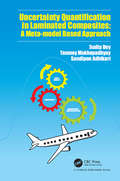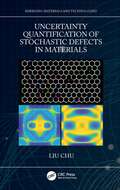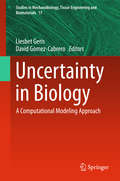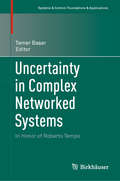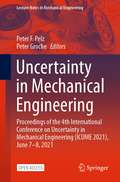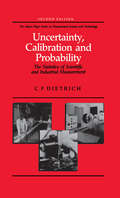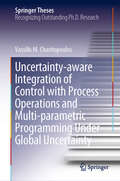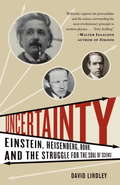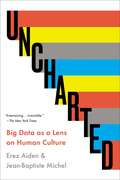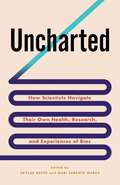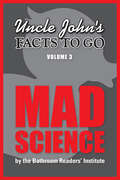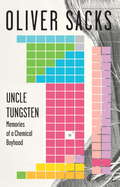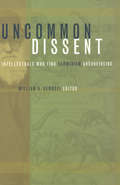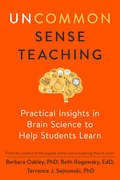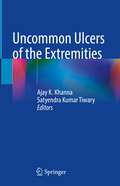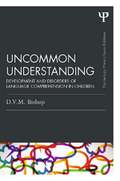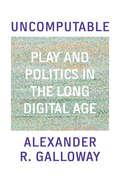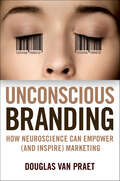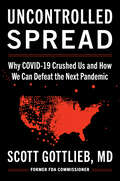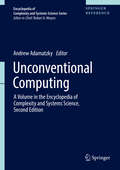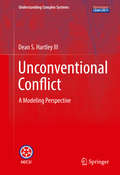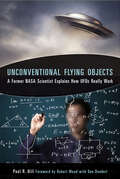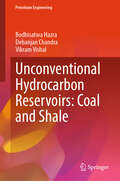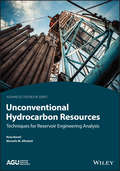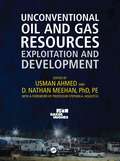- Table View
- List View
Uncertainty Quantification in Laminated Composites: A Meta-model Based Approach
by Sondipon Adhikari Sudip Dey Tanmoy MukhopadhyayOver the last few decades, uncertainty quantification in composite materials and structures has gained a lot of attention from the research community as a result of industrial requirements. This book presents computationally efficient uncertainty quantification schemes following meta-model-based approaches for stochasticity in material and geometric parameters of laminated composite structures. Several metamodels have been studied and comparative results have been presented for different static and dynamic responses. Results for sensitivity analyses are provided for a comprehensive coverage of the relative importance of different material and geometric parameters in the global structural responses.
Uncertainty Quantification of Stochastic Defects in Materials (Emerging Materials and Technologies)
by Liu ChuUncertainty Quantification of Stochastic Defects in Materials investigates the uncertainty quantification methods for stochastic defects in material microstructures. It provides effective supplementary approaches for conventional experimental observation with the consideration of stochastic factors and uncertainty propagation. Pursuing a comprehensive numerical analytical system, this book establishes a fundamental framework for this topic, while emphasizing the importance of stochastic and uncertainty quantification analysis and the significant influence of microstructure defects on the material macro properties. Key Features Consists of two parts: one exploring methods and theories and the other detailing related examples Defines stochastic defects in materials and presents the uncertainty quantification for defect location, size, geometrical configuration, and instability Introduces general Monte Carlo methods, polynomial chaos expansion, stochastic finite element methods, and machine learning methods Provides a variety of examples to support the introduced methods and theories Applicable to MATLAB and ANSYS software This book is intended for advanced students interested in material defect quantification methods and material reliability assessment, researchers investigating artificial material microstructure optimization, and engineers working on defect influence analysis and nondestructive defect testing.
Uncertainty in Biology
by Liesbet Geris David Gomez-CabreroComputational modeling allows to reduce, refine and replace animal experimentation as well as to translate findings obtained in these experiments to the human background. However these biomedical problems are inherently complex with a myriad of influencing factors, which strongly complicates the model building and validation process. This book wants to address four main issues related to the building and validation of computational models of biomedical processes: 1. Modeling establishment under uncertainty 2. Model selection and parameter fitting 3. Sensitivity analysis and model adaptation 4. Model predictions under uncertainty In each of the abovementioned areas, the book discusses a number of key-techniques by means of a general theoretical description followed by one or more practical examples. This book is intended for graduate students and researchers active in the field of computational modeling of biomedical processes who seek to acquaint themselves with the different ways in which to study the parameter space of their model as well as its overall behavior.
Uncertainty in Complex Networked Systems: In Honor of Roberto Tempo (Systems & Control: Foundations & Applications)
by Tamer BaşarThe chapters in this volume, and the volume itself, celebrate the life and research of Roberto Tempo, a leader in the study of complex networked systems, their analysis and control under uncertainty, and robust designs. Contributors include authorities on uncertainty in systems, robustness, networked and network systems, social networks, distributed and randomized algorithms, and multi-agent systems—all fields that Roberto Tempo made vital contributions to. Additionally, at least one author of each chapter was a research collaborator of Roberto Tempo’s.This volume is structured in three parts. The first covers robustness and includes topics like time-invariant uncertainties, robust static output feedback design, and the uncertainty quartet. The second part is focused on randomization and probabilistic methods, which covers topics such as compressive sensing, and stochastic optimization. Finally, the third part deals with distributed systems and algorithms, and explores matters involving mathematical sociology, fault diagnoses, and PageRank computation.Each chapter presents exposition, provides new results, and identifies fruitful future directions in research. This book will serve as a valuable reference volume to researchers interested in uncertainty, complexity, robustness, optimization, algorithms, and networked systems.
Uncertainty in Mechanical Engineering: Proceedings of the 4th International Conference on Uncertainty in Mechanical Engineering (ICUME 2021), June 7–8, 2021 (Lecture Notes in Mechanical Engineering)
by Peter Groche Peter F. PelzThis open access book reports on methods and technologies to describe, evaluate and control uncertainty in mechanical engineering applications. It brings together contributions by engineers, mathematicians and legal experts, offering a multidisciplinary perspective on the main issues affecting uncertainty throughout the complete system lifetime, which includes process and product planning, development, production and usage. The book is based on the proceedings of the 4th International Conference on Uncertainty in Mechanical Engineering (ICUME 2021), organized by the Collaborative Research Center (CRC) 805 of the TU Darmstadt, and held online on June 7–8, 2021. All in all, it offers a timely resource for researchers, graduate students and practitioners in the field of mechanical engineering, production engineering and engineering optimization.
Uncertainty, Calibration and Probability: The Statistics of Scientific and Industrial Measurement
by C.F DietrichAll measurements are subject to error because no quantity can be known exactly; hence, any measurement has a probability of lying within a certain range. The more precise the measurement, the smaller the range of uncertainty. Uncertainty, Calibration and Probability is a comprehensive treatment of the statistics and methods of estimating these calibration uncertainties. The book features the general theory of uncertainty involving the combination (convolution) of non-Gaussian, student t, and Gaussian distributions; the use of rectangular distributions to represent systematic uncertainties; and measurable and nonmeasurable uncertainties that require estimation. The author also discusses sources of measurement errors and curve fitting with numerous examples of uncertainty case studies. Many useful tables and computational formulae are included as well. All formulations are discussed and demonstrated with the minimum of mathematical knowledge assumed. This second edition offers additional examples in each chapter, and detailed additions and alterations made to the text. New chapters consist of the general theory of uncertainty and applications to industry and a new section discusses the use of orthogonal polynomials in curve fitting. Focusing on practical problems of measurement, Uncertainty, Calibration and Probability is an invaluable reference tool for R&D laboratories in the engineering/manufacturing industries and for undergraduate and graduate students in physics, engineering, and metrology.
Uncertainty-aware Integration of Control with Process Operations and Multi-parametric Programming Under Global Uncertainty (Springer Theses)
by Vassilis M. CharitopoulosThis book introduces models and methodologies that can be employed towards making the Industry 4.0 vision a reality within the process industries, and at the same time investigates the impact of uncertainties in such highly integrated settings. Advances in computing power along with the widespread availability of data have led process industries to consider a new paradigm for automated and more efficient operations. The book presents a theoretically proven optimal solution to multi-parametric linear and mixed-integer linear programs and efficient solutions to problems such as process scheduling and design under global uncertainty. It also proposes a systematic framework for the uncertainty-aware integration of planning, scheduling and control, based on the judicious coupling of reactive and proactive methods. Using these developments, the book demonstrates how the integration of different decision-making layers and their simultaneous optimisation can enhance industrial process operations and their economic resilience in the face of uncertainty.
Uncertainty: Einstein, Heisenberg, Bohr, and the Struggle for the Soul of Science
by David LindleyThe more precisely the position is determined, the less precisely the momentum is known in this instant, and vice versa. --Werner Heisenberg <P> That God would choose to play dice with the world is something I cannot believe. --Albert Einstein <P> Nothing exists until it is measured. --Neils Bohr <P> The remarkable story of a startling scientific idea that ignited a battle among the greatest minds of the twentieth century and profoundly influenced intellectual inquiry in fields ranging from physics to literary criticism, anthropology and journalism In 1927, the young German physicist Werner Heisenberg challenged centuries of scientific understanding when he introduced what came to be known as "the uncertainty principle. " Building on his own radical innovations in quantum theory, Heisenberg proved that in many physical measurements, you can obtain one bit of information only at the price of losing another. Heisenberg's principle implied that scientific quantities/concepts do not have absolute, independent meaning, but acquire meaning only in terms of the experiments used to measure them. This proposition, undermining the cherished belief that science could reveal the physical world with limitless detail and precision, placed Heisenberg in direct opposition to the revered Albert Einstein. The eminent scientist Niels Bohr, Heisenberg's mentor and Einstein's long-time friend, found himself caught between the two. Uncertaintychronicles the birth and evolution of one of the most significant findings in the history of science, and portrays the clash of ideas and personalities it provoked. Einstein was emotionally as well as intellectually determined to prove the uncertainty principle false. Heisenberg represented a new generation of physicists who believed that quantum theory overthrew the old certainties; confident of his reasoning, Heisenberg dismissed Einstein's objections. Bohr understood that Heisenberg was correct, but he also recognized the vital necessity of gaining Einstein's support as the world faced the shocking implications of Heisenberg's principle.
Uncharted
by Erez AidenBreaking open Big Data, two Harvard scientists reveal a ground-breaking way of looking at history and culture. One of the greatest untapped resources of today isn’t offshore oil or natural gas-it’s data. Gigabytes, exabytes (that’s one quintillion bytes) of data are sitting on servers across the world. So how can we start to access this explosion of information, this "big data,” and what can it tell us? Erez Aiden and Jean-Baptiste Michel are two young scientists at Harvard who started to ask those questions. They teamed up with Google to create the Ngram Viewer, a Web-based tool that can chart words throughout the massive Google Books archive, sifting through billions of words to find fascinating cultural trends. On the day that the Ngram Viewer debuted in 2010, more than one million queries were run through it. On the front lines of Big Data, Aiden and Michel realized that this big dataset-the Google Books archive that contains remarkable information on the human experience-had huge implications for looking at our shared human history. The tool they developed to delve into the data has enabled researchers to track how our language has evolved over time, how art has been censored, how fame can grow and fade, how nations trend toward war. How we remember and how we forget. And ultimately, how Big Data is changing the game for the sciences, humanities, politics, business, and our culture. .
Uncharted: How Scientists Navigate Their Own Health, Research, and Experiences of Bias
by Skylar Bayer Gabriela Serrato MarksPeople with disabilities are underrepresented in STEM fields, and all too often, they face isolation and ableism in academia. Uncharted is a collection of powerful first-person stories by current and former scientists with disabilities or chronic conditions who have faced changes in their careers, including both successes and challenges, because of their health. It gives voice to common experiences that are frequently overlooked or left unspoken. These deeply personal accounts describe not only health challenges but also the joys, sorrows, humor, and wonder of science and scientists.With a breadth of perspectives on being disabled or chronically ill, these stories highlight the intersectionality of minoritized identities with the disability community. Uncharted features essays by contributors who are d/Deaf, blind, neurodivergent, wheelchair users, have experienced traumatic brain injuries, have blood sugar disorders, have rare medical diagnoses, or have received psychiatric diagnoses, among many others. In many cases, the scientific field is not fully accessible to them, and they frankly describe struggling as well as thriving alongside their conditions.This book serves as representation for scientists who have never felt comfortable disclosing their disability or who have never felt fully understood. The stories shared in this book seek to normalize medical conditions and disabilities in scientific culture, offering recommendations for how and why to improve access. Uncharted is vital and compelling reading for current and aspiring scientists who want to make their fields more inclusive and supportive for everyone.
Uncle John's Facts to Go: Mad Science (Facts to Go #3)
by Bathroom Readers' InstituteA collection of crazy science facts on everything from rocket ships and death rays to atoms, experiments, and bizarre scientists. From the amazing to the amusing, this byte-sized collection will bring you the inside stories behind earth-shattering discoveries, accidental inventions, and outlandish studies. Featuring Uncle John&’s most mind-bending science articles—along with a few all-new &“experiments&”—this book will make you think, make you laugh, and make you ask yourself, &“What the heck were they thinking?&” Get ready to cackle like a mad scientist as you uncover the truth about . . . · The mystery of Tesla&’s death ray machine · How to reanimate the dead · The next space race: Interstellar travel · Serendipity: The origins of the microwave oven and Silly Putty · The eccentric Dr. Einstein · The simple science behind nuclear fission · &“Pigeons&’ Ability to Discriminate Between Monet and Picasso&” and other strange-but-true studies · Toilets in Spaaaaace! And much, much more
Uncle Tungsten: Memories of a Chemical Boyhood
by Oliver SacksLong before Oliver Sacks became a distinguished neurologist and bestselling writer, he was a small English boy fascinated by metals–also by chemical reactions (the louder and smellier the better), photography, squids and cuttlefish, H.G. Wells, and the periodic table. In this endlessly charming and eloquent memoir, the author of The Man Who Mistook His Wife for a Hat and Awakenings chronicles his love affair with science and the magnificently odd and sometimes harrowing childhood in which that love affair unfolded.In Uncle Tungsten we meet Sacks’ extraordinary family, from his surgeon mother (who introduces the fourteen-year-old Oliver to the art of human dissection) and his father, a family doctor who imbues in his son an early enthusiasm for housecalls, to his “Uncle Tungsten,” whose factory produces tungsten-filament lightbulbs. We follow the young Oliver as he is exiled at the age of six to a grim, sadistic boarding school to escape the London Blitz, and later watch as he sets about passionately reliving the exploits of his chemical heroes–in his own home laboratory. Uncle Tungsten is a crystalline view of a brilliant young mind springing to life, a story of growing up which is by turns elegiac, comic, and wistful, full of the electrifying joy of discovery.
Uncommon Dissent: Intellectuals Who Find Darwinism Unconvincing
by William DembskiRecent years have seen the rise to prominence of ever more sophisticated philosophical and scientific critiques of the ideas marketed under the name of Darwinism. In Uncommon Dissent, mathematician and philosopher William A. Dembski brings together essays by leading intellectuals who find one or more aspects of Darwinism unpersuasive. As Dembski explains, Darwinism has gathered around itself an aura of invincibility that is inhospitable to rational discussion--to say the least: "Darwinism, its proponents assure us, has been overwhelmingly vindicated. Any resistance to it is futile and indicates bad faith or worse." Indeed, those who question the Darwinian synthesis are supposed, in the famous formulation of Richard Dawkins, to be ignorant, stupid, insane, or wicked.The hostility of dogmatic Darwinians like Dawkins has not, however, prevented the advent of a growing cadre of scholarly critics of metaphysical Darwinism. The measured, thought-provoking essays in Uncommon Dissent make it increasingly obvious that these critics are not the brainwashed fundamentalist buffoons that Darwinism's defenders suggest they are, but rather serious, skeptical, open-minded inquirers whose challenges pose serious questions about the viability of Darwinist ideology. The intellectual power of their contributions to Uncommon Dissent is bracing.
Uncommon Sense Teaching: Practical Insights in Brain Science to Help Students Learn
by Terrence J. Sejnowski Barbara Oakley Beth RogowskyA groundbreaking guide to improve teaching based on the latest research in neuroscience, from the bestselling author of A Mind for Numbers.Neuroscientists and cognitive scientists have made enormous strides in understanding the brain and how we learn, but little of that insight has filtered down to the way teachers teach. Uncommon Sense Teaching applies this research to the classroom for teachers, parents, and anyone interested in improving education. Topics include: • keeping students motivated and engaged, especially with online learning • helping students remember information long-term, so it isn't immediately forgotten after a test • how to teach inclusively in a diverse classroom where students have a wide range of abilitiesDrawing on research findings as well as the authors' combined decades of experience in the classroom, Uncommon Sense Teaching equips readers with the tools to enhance their teaching, whether they're seasoned professionals or parents trying to offer extra support for their children's education.
Uncommon Ulcers of the Extremities
by Ajay K. Khanna Satyendra Kumar TiwaryThe book covers all uncommon ulcers of the extremities which remain a difficult diagnosis for clinicians most of the times. A variety of causes like metabolic, infective, rheumatoid, drug induced or inflammation may lead to ulcerations. Diagnosis of these ulceration is difficult as these diseases are systemic, and treatment is carried out by physicians but ulcers are managed by the surgeons. Any lacunae or gap in assessment or work-up may lead to failure in diagnosis and increased morbidity. This book provides a systematic and step wise approach to the differential diagnosis of every possible uncommon ulcers in the extremities with detailed work-up, flow chart and summary. The book is systematically designed to serve the purpose of covering every possible uncommon ulcer with elaborate clinical presentation in the background of etiology and pathogenesis with risk factors included investigations and treatment with medical, surgical options well discussed as per the requirement. The book includes illustrations, flow diagrams, images, charts and tables. The book provides every information clinically relevant and useful about the uncommon ulcers and serves as a complete resource for general surgeons, vascular surgeons, plastic surgeons, orthopedic surgeons, surgical trainees, family physicians. It may also be useful for podiatrists, phlebologists, radiologists, cardiologists, nephrologists, neurologists, wound care nurses, physicians and primary care workers.
Uncommon Understanding: Development and disorders of language comprehension in children (Psychology Press & Routledge Classic Editions)
by Dorothy V. BishopThis is a Classic Edition of Dorothy Bishop's award-winning textbook on the development of language comprehension, which has been in print since 1997, and now includes a new introduction from the author. The book won the British Psychological Society book award in 1999, and is now widely seen as a classic in the field of developmental language disorders. Uncommon Understanding provides a comprehensive account of the process of comprehension, from the reception of an acoustic signal, to the interpretation of communicative intentions, and integrates a vast field of research on language acquisition, psycholinguistics and neuropsychology. In the new introduction Dorothy Bishop reflects on the organization of the book, and developments in the field since the book was first published. A major theme in the book is that comprehension should not be viewed as a unitary skill – to understand spoken language one needs the ability to classify incoming speech sounds, to relate them to a "mental lexicon," to interpret the propositions encoded by word order and grammatical inflections, and to use information from the environmental and social context to grasp an intended meaning. Another important theme is that although neuropsychological and experimental research on adult comprehension provides useful concepts and methods for assessing comprehension, it should be applied with caution, because a sequential, bottom-up information processing model of comprehension is ill-suited to the developmental context. Although the main focus of the book is on research and theory, rather than practical matters of assessment and intervention, the theoretical framework presented in the book will continue to help clinicians develop a clearer understanding of what comprehension involves, and how different types of difficulty may be pin-pointed.
Uncomputable: Play and Politics In the Long Digital Age
by Alexander GallowayA journey through the uncomputable remains of computer historyNarrating some lesser known episodes from the deep history of digital machines, Alexander R. Galloway explains the technology that drives the world today, and the fascinating people who brought these machines to life. With an eye to both the computable and the uncomputable, Galloway shows how computation emerges or fails to emerge, how the digital thrives but also atrophies, how networks interconnect while also fray and fall apart. By re-building obsolete technology using today's software, the past comes to light in new ways, from intricate algebraic patterns woven on a hand loom, to striking artificial-life simulations, to war games and back boxes. A description of the past, this book is also an assessment of all that remains uncomputable as we continue to live in the aftermath of the long digital age.
Unconscious Branding: How Neuroscience Can Empower (and Inspire) Marketing
by Douglas Van PraetFor too long marketers have been asking the wrong question. If consumers make decisions unconsciously, why do we persist in asking them directly through traditional marketing research why they do what they do? They simply can't tell us because they don't really know. Before marketers develop strategies, they need to recognize that consumers have strategies too . . .human strategies, not consumer strategies. We need to go beyond asking why, and begin to ask how,behavior change occurs. Here, author DouglasVan Praet takes the most brilliant and revolutionary concepts from cognitive science and applies them to how we market, advertise, and consume in the modern digital age. Van Praet simplifies the most complex object in the known universe - the human brain - into seven codified actionable steps to behavior change. These steps are illustrated using real world examples from advertising, marketing, media and business to consciously unravel what brilliant marketers and ad practitioners have long done intuitively, deconstructing the real story behind some of the greatest marketing and business successes in recent history, such as Nike's "Just Do It" campaign; "Got Milk?"; Wendy's "Where's the Beef?" ;and the infamous Volkswagen "Punch Buggy" launch as well as their beloved "The Force" (Mini Darth Vader) Super Bowl commercial.
Uncontrolled Spread: Why COVID-19 Crushed Us and How We Can Defeat the Next Pandemic
by Scott GottliebNEW YORK TIMES BESTSELLER“Uncontrolled Spread is everything you’d hope: a smart and insightful account of what happened and, currently, the best guide to what needs to be done to avoid a future pandemic." —Wall Street Journal“Informative and well paced.”—The Guardian“An intense ride through the pandemic with chilling details of what really happened. It is also sprinkled with notes of true wisdom that may help all of us better prepare for the future.”—Sanjay Gupta, MD, chief medical correspondent, CNNPhysician and former FDA commissioner Scott Gottlieb asks: Has America’s COVID-19 catastrophe taught us anything?In Uncontrolled Spread, he shows how the coronavirus and its variants were able to trounce America’s pandemic preparations, and he outlines the steps that must be taken to protect against the next outbreak. As the pandemic unfolded, Gottlieb was in regular contact with all the key players in Congress, the Trump administration, and the drug and diagnostic industries. He provides an inside account of how level after level of American government crumbled as the COVID-19 crisis advanced.A system-wide failure across government institutions left the nation blind to the threat, and unable to mount an effective response. We’d prepared for the wrong virus. We failed to identify the contagion early enough and became overly reliant on costly and sometimes divisive tactics that couldn’t fully slow the spread. We never considered asymptomatic transmission and we assumed people would follow public health guidance. Key bureaucracies like the CDC were hidebound and outmatched. Weak political leadership aggravated these woes. We didn’t view a public health disaster as a threat to our national security.Many of the woes sprung from the CDC, which has very little real-time reporting capability to inform us of Covid’s twists and turns or assess our defenses. The agency lacked an operational capacity and mindset to mobilize the kind of national response that was needed. To guard against future pandemic risks, we must remake the CDC and properly equip it to better confront crises. We must also get our intelligence services more engaged in the global public health mission, to gather information and uncover emerging risks before they hit our shores so we can head them off. For this role, our clandestine agencies have tools and capabilities that the CDC lacks.Uncontrolled Spread argues we must fix our systems and prepare for a deadlier coronavirus variant, a flu pandemic, or whatever else nature -- or those wishing us harm -- may threaten us with. Gottlieb outlines policies and investments that are essential to prepare the United States and the world for future threats.
Unconventional Computing: A Volume in the Encyclopedia of Complexity and Systems Science, Second Edition (Encyclopedia of Complexity and Systems Science Series #22)
by Andrew AdamatzkyThis volume of the Encyclopedia of Complexity and Systems Science, Second Edition, is a unique collection of concise overviews of state-of-art, theoretical and experimental findings, prepared by the world leaders in unconventional computing. Topics covered include bacterial computing, artificial chemistry, amorphous computing, computing with Solitons, evolution in materio, immune computing, mechanical computing, molecular automata, membrane computing, bio-inspired metaheuristics, reversible computing, sound and music computing, enzyme-based computing, structural machines, reservoir computing, infinity computing, biomolecular data structures, slime mold computing, nanocomputers, analog computers, DNA computing, novel hardware, thermodynamics of computation, and quantum and optical computing. Topics added to the second edition include: social algorithms, unconventional computational problems, enzyme-based computing, inductive Turing machines, reservoir computing, Grossone Infinity computing, slime mould computing, biomolecular data structures, parallelization of bio-inspired unconventional computing, and photonic computing.Unconventional computing is a cross-breed of computer science, physics, mathematics, chemistry, electronic engineering, biology, materials science and nanotechnology. The aims are to uncover and exploit principles and mechanisms of information processing in, and functional properties of, physical, chemical and living systems, with the goal to develop efficient algorithms, design optimal architectures and manufacture working prototypes of future and emergent computing devices.
Unconventional Conflict: A Modeling Perspective (Understanding Complex Systems)
by Dean S. Hartley IIIThis book describes issues in modeling unconventional conflict and suggests a new way to do the modeling. It presents an ontology that describes the unconventional conflict domain, which allows for greater ease in modeling unconventional conflict. Supporting holistic modeling, which means that we can see the entire picture of what needs to be modeled, the ontology allows us to make informed decisions about what to model and what to omit. The unconventional conflict ontology also separates the things we understand best from the things we understand least. This separation means that we can perform verification, validation and accreditation (VV&A) more efficiently and can describe the competence of the model more accurately.However, before this message can be presented in its entirety the supporting body of knowledge has to be explored. For this reason, the book offers chapters that focus on the description of unconventional conflict and the analyses that have been performed, modeling, with a concentration on past efforts at modeling unconventional conflict, the precursors to the ontology, and VV&A. Unconventional conflict is a complex, messy thing. It normally involves multiple actors, with their own conflicting agendas and differing concepts of legitimate actions. This book will present a useful introduction for researchers and professionals within the field.
Unconventional Flying Objects: A Former NASA Scientist Explains How UFOs Really Work
by Paul R. HillA NASA R&D engineer does “a masterful job ferreting out the basic science and technology behind the elusive UFO characteristics.” —Edgar Mitchell, Sc.D., Apollo 14 AstronautPaul Hill was a well-respected NASA scientist when, in the early 1950s, he had a UFO sighting. Soon after, he built the first flying platform and was able to duplicate the UFO’s tilt-to-control maneuvers. Official policy, however, prevented him from proclaiming his findings. “I was destined,” says Hill, “to remain as unidentified as the flying objects.”For the next twenty-five years, Hill acted as an unofficial clearing house at NASA, collecting and analyzing sightings’ reports for physical properties, propulsion possibilities, dynamics and more. To refute claims that UFOs defy the laws of physics, he had to make “technological sense . . . of the unconventional object.”After his retirement from NASA, Hill finally completed his remarkable analysis. In Unconventional Flying Objects, published posthumously, he presents his findings that UFOs “obey, not defy, the laws of physics.” Vindicating his own sighting and thousands of others, he proves that UFO technology is not only explainable, but attainable.
Unconventional Hydrocarbon Reservoirs: Coal and Shale (Petroleum Engineering)
by Bodhisatwa Hazra Debanjan Chandra Vikram VishalThis informative book offers a comprehensive exploration of critical reservoir parameters, including quantification techniques and interpretations for evaluating these reservoirs. Readers will also gain insight into the fundamental principles of simulating gas production from coal and shale reservoirs, as well as the key input parameters for building the best-fit reservoir model. Additionally, the book explores various aspects of storing captured CO2 in these reservoirs and their potential role in preventing global temperature increases beyond pre-industrial levels.Energy from conventional petroleum reservoirs and coal has been the backbone of global energy needs for a long time. However, depletion of these fossil fuel reserves, as well as their contribution to rising greenhouse emissions, has prompted a shift to renewable energy sources. Natural gas found in unconventional coal and shale reservoirs is increasingly seen as a greener energy option, emitting approximately 45% less CO2 than conventional sources. Furthermore, due to their vast availability and capacity to sequester atmospheric CO2, unconventional coal and shale reservoirs can facilitate the transition to renewable energy resources.With a focus on achieving temperature stabilization at 1.5°C, this book offers a valuable resource for those interested in renewable energy and mitigating climate change.
Unconventional Hydrocarbon Resources: Techniques for Reservoir Engineering Analysis (AGU Advanced Textbooks #1)
by Reza Barati Mustafa M. AlhubailA comprehensive textbook presenting techniques for the analysis and characterization of shale plays Significant reserves of hydrocarbons cannot be extracted using conventional methods. Improvements in techniques such as horizontal drilling and hydraulic fracturing have increased access to unconventional hydrocarbon resources, ushering in the “shale boom” and disrupting the energy sector. Unconventional Hydrocarbon Resources: Techniques for Reservoir Engineering Analysis covers the geochemistry, petrophysics, geomechanics, and economics of unconventional shale oil plays. The text uses a step-by-step approach to demonstrate industry-standard workflows for calculating resource volume and optimizing the extraction process. Volume highlights include: Methods for rock and fluid characterization of unconventional shale plays A workflow for analyzing wells with stimulated reservoir volume regions An unconventional approach to understanding of fluid flow through porous media A comprehensive summary of discoveries of massive shale resources worldwide Data from Eagle Ford, Woodford, Wolfcamp, and The Bakken shale plays Examples, homework assignments, projects, and access to supplementary online resources Hands-on teaching materials for use in petroleum engineering software applications The American Geophysical Union promotes discovery in Earth and space science for the benefit of humanity. Its publications disseminate scientific knowledge and provide resources for researchers, students, and professionals.
Unconventional Oil and Gas Resources: Exploitation and Development (Emerging Trends and Technologies in Petroleum Engineering)
by Usman Ahmed D. Nathan MeehanAs the shale revolution continues in North America, unconventional resource markets are emerging on every continent. In the next eight to ten years, more than 100,000 wells and one- to two-million hydraulic fracturing stages could be executed, resulting in close to one trillion dollars in industry spending. This growth has prompted professionals ex
